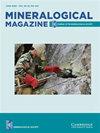俄罗斯堪察加半岛托尔巴奇克火山Arsenatnaya富马孔中的新砷酸盐矿物。XIX。Axelite,Na14Cu7(AsO4)8F2Cl2
IF 1.4
3区 地球科学
Q2 MINERALOGY
引用次数: 0
摘要
摘要:在俄罗斯堪察加托尔巴切克火山大托尔巴切克裂缝北突第二火山锥的Arsenatnaya火山喷发孔中发现了新的轴晶矿物Na14Cu7(AsO4)8F2Cl2。它与钾辉石、盐辉石、铁绢云母、钾辉石、钾辉石、钙辉石、钙辉石、赤铁矿、钾辉石、锡辉石、钾辉石、钾辉石、钾辉石群硫酸盐、硬石膏、氟辉石、钾辉石和氟辉石伴生。轴晶以板状、二次型、矩形或更强的扭曲晶体的形式出现,最大可达0.02 × 0.1 × 0.1 mm,有时在生长过度的钾盐上形成长达0.4 mm的间断结壳。它是透明的,天蓝色的,有玻璃般的光泽。未观察到乳沟。Dcalc为3.662 g cm-3。Axelite是光学单轴的(-),其系数为1.650(4),ω为1.678(4)。化学成分(wt.%,电子探针数据)为:Na2O 22.54, K2O 0.08, CaO 0.04, MgO 0.05, CuO 26.69, P2O5 1.75, V2O5 0.15, As2O5 44.14, SO3 0.04, F 1.57, Cl 3.60, -O =(F,Cl) -1.47,共99.18。基于O+F+Cl=36 apfu的经验公式为na14.37 k0.03 ca0.01 mg0.02 cu6.63 p0.49 v0.03 as7.59 s0.010 32.36 f1.63 cl2.01。Axelite为四边形,P4bm, a = 14.5957(2), c = 8.34370(18) Å, V = 1777.51(6) Å3, Z = 2。粉末x射线衍射(XRD)图的最强反射[d,Å(I)(hkl)]分别为:8.32(44)(001)、5.156(47)(220)、4.168(21)(002)、3.246(34)(222)、3.180(61)(331)、2.747(100)(402)、2.709(36)(511)和2.580(29)(440)。从单晶XRD数据(R = 4.50%)中解析出的晶体结构是独特的。它是基于CuO4Cl方金字塔与AsO4四面体连接而成的团簇所形成的杂多面体链。相邻链通过AsO4四面体与CuO4Cl金字塔的共同顶点连接,形成异多面体伪框架。Axelite在结构和化学方面都与薰衣草类矿物和合成化合物有较远的关系。这种矿物的命名是为了纪念杰出的芬兰-俄罗斯晶体学家、矿物学家和材料科学家阿克塞尔·加多林(Axel Gadolin, 1828-1892)。本文章由计算机程序翻译,如有差异,请以英文原文为准。
New arsenate minerals from the Arsenatnaya fumarole, Tolbachik volcano, Kamchatka, Russia. XIX. Axelite, Na14Cu7(AsO4)8F2Cl2
Abstract The new mineral axelite, ideally Na14Cu7(AsO4)8F2Cl2, was found in the Arsenatnaya fumarole at the Second scoria cone of the Northern Breakthrough of the Great Tolbachik Fissure Eruption, Tolbachik volcano, Kamchatka, Russia. It is associated with sylvite, halite, arsmirandite, bradaczekite, johillerite, tilasite, ericlaxmanite, lammerite, hematite, tenorite, cassiterite, pseudobrookite, aphthitalite-group sulfates, anhydrite, fluoborite, sanidine and fluorophlogopite. Axelite occurs as tabular, quadratic, rectangular or stronger distorted crystals up to 0.02 × 0.1 × 0.1 mm, sometimes combined in interrupted crusts up to 0.4 mm across overgrowing sylvite. It is transparent, sky-blue, with vitreous lustre. Cleavage was not observed. Dcalc is 3.662 g cm–3. Axelite is optically uniaxial (–), ɛ = 1.650(4) and ω = 1.678(4). Chemical composition (wt.%, electron microprobe data) is: Na2O 22.54, K2O 0.08, CaO 0.04, MgO 0.05, CuO 26.69, P2O5 1.75, V2O5 0.15, As2O5 44.14, SO3 0.04, F 1.57, Cl 3.60, –O=(F,Cl) –1.47, total 99.18. The empirical formula based on O+F+Cl=36 apfu is Na14.37K0.03Ca0.01Mg0.02Cu6.63P0.49V0.03As7.59S0.01O32.36F1.63Cl2.01. Axelite is tetragonal, P4bm, a = 14.5957(2), c = 8.34370(18) Å, V = 1777.51(6) Å3 and Z = 2. The strongest reflections of the powder X-ray diffraction (XRD) pattern [d,Å(I)(hkl)] are: 8.32(44)(001), 5.156(47)(220), 4.168(21)(002), 3.246(34)(222), 3.180(61)(331), 2.747(100)(402), 2.709(36)(511) and 2.580(29)(440). The crystal structure, solved from single-crystal XRD data (R = 4.50%), is unique. It is based on the heteropolyhedral chains built by clusters formed by CuO4Cl square pyramids connected with AsO4 tetrahedra. Adjacent chains are connected via common vertices of AsO4 tetrahedra with CuO4Cl pyramids to form a heteropolyhedral pseudo-framework. Axelite is remotely related, in both structural and chemical aspects, to lavendulan-like minerals and synthetic compounds. The mineral is named in honour of the outstanding Finnish–Russian crystallographer, mineralogist and material scientist Axel Gadolin (1828–1892).
求助全文
通过发布文献求助,成功后即可免费获取论文全文。
去求助
来源期刊

Mineralogical Magazine
地学-矿物学
CiteScore
4.00
自引率
25.90%
发文量
104
审稿时长
6-12 weeks
期刊介绍:
Mineralogical Magazine is an international journal of mineral sciences which covers the fields of mineralogy, crystallography, geochemistry, petrology, environmental geology and economic geology. The journal has been published continuously since the founding of the Mineralogical Society of Great Britain and Ireland in 1876 and is a leading journal in its field.
 求助内容:
求助内容: 应助结果提醒方式:
应助结果提醒方式:


